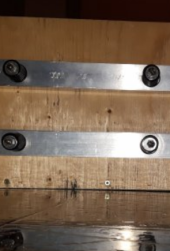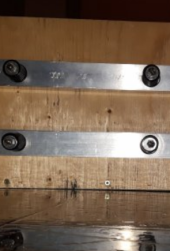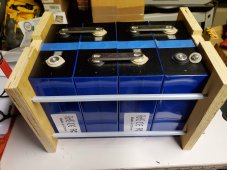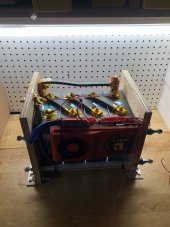I do believe I understand what you are saying, I may not be doing a good job of explaining.
If you have 1 row of cells you have the 660 lbs. 330 lbs on each side, 165 on each rod:

If you have 2 rows of separate cells you would now have 8 springs total. Each separate plate seeing 660 for a total of 1320 lbs:


You now want to join the plates together and eliminate one of the two rows of springs in the middle but you must maintain the the 1320lbs.
What you have suggested is that you should just average the 1320 over the 6 springs so each would be seeing 220lbs. Why would you do that? That force was in that location for a reason. Why would you all of a sudden decide the outside of the cells need more force simply because you changed the number of springs?

If you left the 4 springs in the middle of the pack you would still average the 1320 over the 8 springs and each would still have 165lbs on each rod. You have now eliminated 2 springs from the middle. The remaining middle two springs need to make up that pressure loss in that location.
As I said in the last post, if you dont think deflection is an issue, you can average out. If that is the case then why even have 6 springs? Just use 4 springs, two on each side that each see 330lbs and call it a day. You still have 1320lbs but I suspect that most people will not think that is such a good idea. Having the middle row helps even out the force. If you are going to go to the trouble of adding the middle row of springs, why not take out any deflection possibility and make the tiny extra effort and simply make sure the force is being applied evenly to each side of each row of cells.
To answer you question directly: Each rod on the outside of the pack would still see 165lbs. The rods that are between cells would need to see double that so 330lbs because they are working acting on two sets of cells, not just one.
If you have 1 row of cells you have the 660 lbs. 330 lbs on each side, 165 on each rod:

If you have 2 rows of separate cells you would now have 8 springs total. Each separate plate seeing 660 for a total of 1320 lbs:


You now want to join the plates together and eliminate one of the two rows of springs in the middle but you must maintain the the 1320lbs.
What you have suggested is that you should just average the 1320 over the 6 springs so each would be seeing 220lbs. Why would you do that? That force was in that location for a reason. Why would you all of a sudden decide the outside of the cells need more force simply because you changed the number of springs?

If you left the 4 springs in the middle of the pack you would still average the 1320 over the 8 springs and each would still have 165lbs on each rod. You have now eliminated 2 springs from the middle. The remaining middle two springs need to make up that pressure loss in that location.
As I said in the last post, if you dont think deflection is an issue, you can average out. If that is the case then why even have 6 springs? Just use 4 springs, two on each side that each see 330lbs and call it a day. You still have 1320lbs but I suspect that most people will not think that is such a good idea. Having the middle row helps even out the force. If you are going to go to the trouble of adding the middle row of springs, why not take out any deflection possibility and make the tiny extra effort and simply make sure the force is being applied evenly to each side of each row of cells.
To answer you question directly: Each rod on the outside of the pack would still see 165lbs. The rods that are between cells would need to see double that so 330lbs because they are working acting on two sets of cells, not just one.
Last edited:







